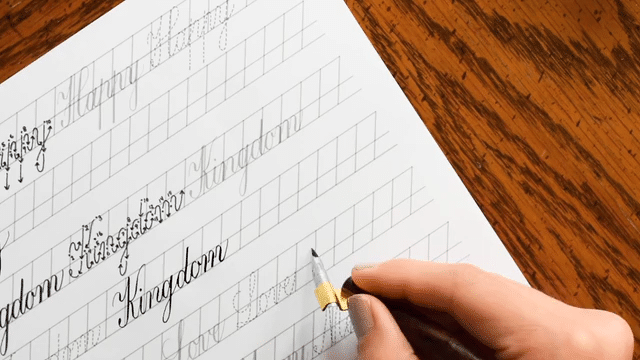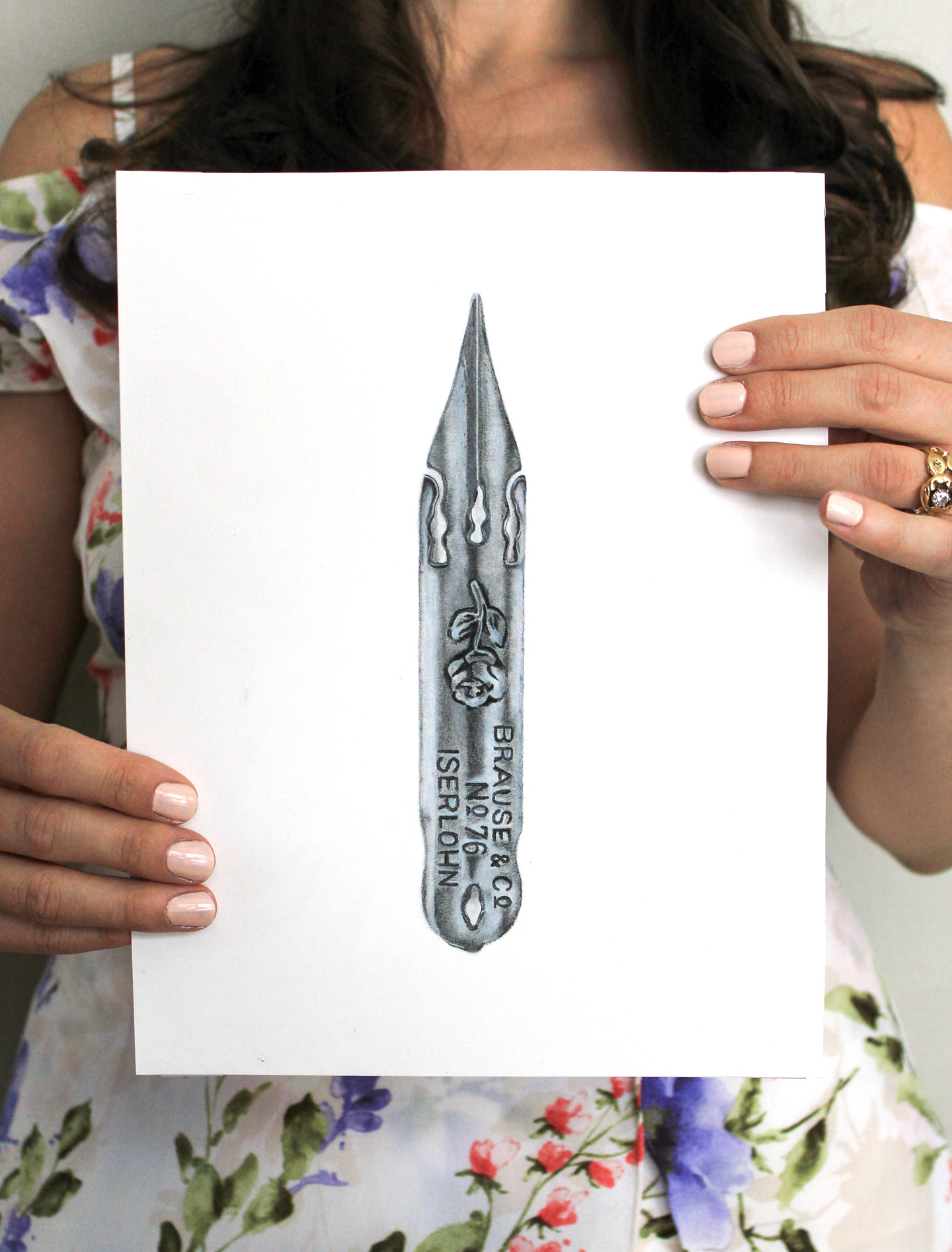
I post short, creative tutorials on the TPK Facebook page a few times per month! That said, I know that many readers aren’t Facebook users, so every so often, it’s nice to post a round-up of tutorials here on the TPK blog. While past roundups have mostly included envelope art, today’s roundup is a little bit of everything! We’ve got a very artistic envelope, an illustrated alphabet letter, and a rubber stamp. Let’s start with the envelope!
Illustrated Hutch Envelope Art

I got the idea for this envelope art from an issue of Flow Magazine. If you are a fan of creative tutorials, you will really love Flow! Whenever you find yourself in a bit of a creative slump, the magazine will be there to save the day — and that was absolutely the case with this project for me. You can see in the photo below that Flow happened to have a great little “lesson” over how to draw a hutch and jars.

I love the look of vintage hutches and china cabinets, so I found a photo online of a fairly ornate hutch. I used that photo as a reference to draw a hutch similar to it on an envelope. You’ll notice that I rotated the envelope such that it has a vertical orientation. That orientation is a little bit risky as far as ensuring delivery goes, so if you’d like to make the envelope more post-office friendly, you can always keep the envelope at a horizontal orientation and draw a short, wide hutch!
I’d like to add that if you are not confident in your free-hand drawing abilities, you can print off your reference photo, stick it in your envelope, and use a light box or an open window to trace over the photo. No matter what you do, though, make sure you use a waterproof ink to draw: I’m using Ziller Soot Black and a crow quill pen.

Once you’re finished drawing the hutch, you can draw pantry goods on its shelves that spell out your recipient’s address. You can see in the photo below that I have left the top shelf blank to accommodate postage stamps, then the second row spells out “JODEAN COOPER” in Sans Serif lettering on various goods. The bottom shelf depicts Jodean’s address via product labels on cans, boxes, and jars.

Next, use watercolor paint to add a pop of color to the hutch and the goods on its shelves!

Finally, make sure you add sufficient postage to the piece to ensure that it reaches its final destination. This envelope has an unconventional orientation, so I added $0.30 worth of extra stamps to cover the non-machinable fee that USPS charges ($0.22).

I’m not going to pretend that envelope art like this — meaning: envelopes that require postal workers to visually hunt a bit for the address — will go through every time with a 100% success rate. I have heard feedback from readers that some post offices will reject mail art that doesn’t rigidly conform to USPS standards. That said, my local post office (Boulder, Colorado) is very tolerant, and this envelope actually reached its destination without a hitch! If you’re brave, you might give this concept a try, too! You can always modify the design such that the address stands out more. Either way, it’s a fun motif, and worth utilizing on anything from mail art to greeting cards!
Ocean-Themed Letter Art

The second of today’s creative tutorials will appeal to anyone who loves sushi or the sea! To make it, start by creating a sketch of a letter; if you’re drawing on black paper, a soapstone pencil is great for this. Make sure the letter includes a wide area inside which you can draw a few fish! You can also make a few swirls around the outside of the letter and try to incorporate a fin or two somewhere. Once your sketch is finished, start drawing or painting over it with ink. In this example, I am using white sumi ink.

For thicker lines, you’ll want to paint the ink on. For thinner lines, such as those used to draw the fish, a dip pen is best.

Once the ink is dry, go over the illustration with an eraser to get rid of your sketch lines.

You can finish up the illustration by adding some calligraphy or lettering if you’d like! I wrote (or, to put it more accurately, attempted to write!) “Thank You” in Japanese in the upper right corner to turn this piece into a thank-you card for a local sushi chef.

I know it can be difficult to transfer the concept of this letter art to a letter besides “S” because that’s the example you are seeing here, but really: try it, and see how it goes! I think that part of the beauty of these mini-creative tutorials is the fact that you have some wiggle room to adapt concepts to your own liking. 🙂
Rubber Stamp Tutorial

There is a full, detailed video tutorial over how to make a rubber stamp in the Digitizing Artwork and Calligraphy eCourse, but I’d also like to give a cursory overview here. To make a rubber stamp, you’ll start by creating a black and white illustration or piece of lettering. As you are making the piece, keep the rubber stamp in mind: bold, clear lines are best for making clear impressions.

Once you’re finished with the illustration, scan it in to your computer. Next, go to a website like rubberstamps.net, and choose the size of stamp you would like to make from your illustration. Once you have chosen the stamp size, you can upload your scan as a .jpg file. The website will show you a preview of the stamp, as shown in the screenshot below.

If the preview looks good to you, you can add the stamp to your cart and order it! A 2″x2″ stamp typically costs around $20 including shipping. Considering the stamp will last a lifetime and is custom-made from your own design, that’s not a bad price! If you’re in the US, you should receive your stamp within a week or so.

While you could try DIYing a rubber stamp by way of carving, hiring a company with heavy-duty machines and expertise is more cost-effective when you think about the time it would take you to carve all the tiny details. Machine-made rubber stamps are created with precision, and the company always tests the stamps before sending them out to ensure quality! You can make practically any black and white piece of art or lettering into a rubber stamp; when I used to sell goods on Etsy, I would often use the stamp below to mark my packages.

I hope you enjoyed today’s hodgepodge of short creative tutorials, and that you were inspired to try out at least one of them! For more TPK creative tutorials from the TPK Facebook page, you can check out the mini-tutorials tag here on the blog. If you have any questions, I hope you won’t hesitate to ask — your comments are always welcome.
I’d also like to take this chance to thank those of you who contributed venue suggestions for upcoming workshops yesterday/today on social media! I am really looking forward to traveling this summer and fall to conduct workshops and meet modern calligraphy learners around the country, and your input has helped me so much to get the ball rolling on that. Thanks again!!
Warmly,





















